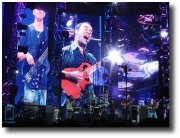by Gary Ewer, from “The Essential Secrets of Songwriting” website. His songwriting e-books are here.
_______________
 There are lots of things that songwriters do to keep a song from getting boring. Varying instrumentation, throwing in rhythmic surprises, coming up with an interesting solo or bridge – these are all ways that we typcially hold a listener’s attention. I love the solution that the Dave Matthews Band uses in “Shake Me Like a Monkey”: a complete change of key in the bridge that moves the song from minor to major. It really works, for a variety of reasons.
There are lots of things that songwriters do to keep a song from getting boring. Varying instrumentation, throwing in rhythmic surprises, coming up with an interesting solo or bridge – these are all ways that we typcially hold a listener’s attention. I love the solution that the Dave Matthews Band uses in “Shake Me Like a Monkey”: a complete change of key in the bridge that moves the song from minor to major. It really works, for a variety of reasons.
“Shake Me Like a Monkey” from the Big Whiskey and the Groogrux King album is powerfully energetic and punchy. The harmonic underlay is simple: for most of the song, G minor is strongly driven home with lots of unison work between guitar and bass, and until the quasi-bridge section at 2’10” the only progression that really appears is the refrain-like harmonic progression “Eb – F – Gm”.
So the chordal palette is somewhat limited in this piece, and for good reason: to really drive a piece home with energy, you need to limit your chord choices, and let the song “sit in there.” Too many chords can take away from the sizzle.
There can, however, be a danger for songs that work with limited harmonies. You run the risk of having your audience feel that they’ve heard it all before you’re even halfway through. You need to do something to keep the song sounding fresh. What DMB does in this song is to do a complete key change at the bridge (2’10”: “Cigarettes and coffee broken heart…“)
The thing about this key change to D major is that it doesn’t really relate all that strongly to the original key of G minor – at least not with regard to musical material. The change from minor to major is pleasantly surprising, and this allows the song to refresh itself by seeming to move in a different direction with a completely different style. The move back to the original feel and key occurs at 2’26” (the instrumental intro to “Kiss Kiss make a wish..“).
I call it a bridge, but it’s really simply a new section that pulls us in a new direction. A bridge usually grows out of the chorus and amplifies the thoughts and emotions of the chorus. Moreover, bridges are usually ways for the writer to take the song to the next level, and to help maintain and build forward momentum. While lyrically the connection is there, this section exists for one main reason: to prevent the song from becoming stale, and in this sense, it works like a bridge.
And it really works. Just those 16 seconds of “diversion” in a new key with a different style allows the previously-established musical motifs to return with renewed vigor and energy.
You may find that changing key in this way is a great solution if your song has lots of punch but just seems to run out of steam. If you’d like some suggestions for key changes that might work which move from major to minor, or vice versa, try playing around with these. The progressions are just samples from each given key. The first example gives an idea of a song primarily in C major that makes use of a new “bridge” section in D minor, with possible progressions, including a smooth way to get back to the original key. The second sample puts together a progression from A minor and F major:
C major -> D minor. Ex: Chorus: C Am G C ->Bridge: Dm Bb C Dm -> transition back: Bb C D Gsus G)
A minor -> F major. Ex: Chorus: Am G Em Am -> Bridge: F Bb Gm Am -> transition back: Gm Am Gm Am)
The possibilities are endless, so experiment!
__________________
Sometimes you need to stop, step back, and look at your songs from a different perspective. Gary Ewer’s songwriting e-books allow you to do just that. They show how good songs work, and how to get your own songs, chord progressions and lyrics working again. Download them here.










I don’t think it works that well at all, sounds like that bridge belongs in a different song. John Mayer crushes Dave in the smooth chorus bridge transition department.
Can you please dissect some of Rhianna’s songs. Stargate’s production always make it to #1 here in US. I think the secret are the bridges. Also, can you write more on instrumentation and how modern production uses synth sounds in place of traditional instruments. How to get parts to lock like counter melodies etc.. You have been very helpful to me in my studies of what makes hit songs tick. There is a site called Queen songs forum where they posted 2008 hit song analysis you should do that. Thank you.